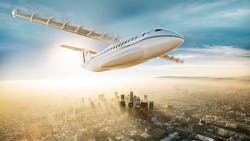German Aerospace Center hosts symposium on the future of electric flight at its E2Flight conference
More than 120 representatives from research institutions and industry exchanged information on the topic of electric flight near Stuttgart in the two-day event held March 28-29.
This year's symposium focused on concepts for for electric flight, hybrid propulsion systems, technical and certification aspects, and propulsion integration based on current projects. But why fly electric compared with traditional rotor and jet aircraft?
"First of all, purely electric flight is locally emission-free, which means that the aircraft itself does not emit any pollutants. Second, both production and maintenance of electric propulsion systems are expected to cost less, thanks to the reduced number of moving parts, said Andreas Klöckner, the coordinator for electric flight at DLR. "And the third advantage is that electric propulsion enables completely new aircraft configurations, which should further reduce fuel consumption, emissions and noise levels."
Related: German Aerospace Center developed de-icing technology using carbon fiber
Air travel is an industry growing around the world, particularly as more people in Asia, South America, and other developing nations areas can afford to fly for travel, including field of electrically-driven aircraft.
"The industry has definitely recognized the potential of electric flight, as is very clear at present," says Josef Kallo, a DLR researcher and co-founder of the symposium. "Almost all the major manufacturers of aircraft, propulsion systems and turbines are already active in this area. Funding agencies in Germany and Europe have also recognized the potential, and are authorising and providing support for various projects."
According to Kallo, the focus is on projects with outputs of between one and two megawatts. This would make it possible to develop aircraft capable of carrying 20 to 40 or 50 passengers on short and regional routes. In this sector, the DLR scientist is counting on new ideas, technologies and projects to emerge from Europe and America.
"There is certainly a palpable sense of optimism," Kallo says. "Science and industry are investigating the possibilities of existing technologies, investing in their development, and intensifying and professionalising their work beyond small research projects."
While electric flight can be "greener" than a traditional jet carrying 20-50 passengers, the amount of power needed to take off carrying that much mass would indeed be noisy, though jet-powered aircraft themselves are not known for their whisper-quiet takeoffs.
"Electric propulsion systems are not in themselves always quiet. Nevertheless, there is considerable potential for noise reduction – although this will require intensive research over the next few years," explains researcher Jan Werner Delfs from the DLR Institute of Aerodynamics and Flow Technology in Braunschweig. "With electrically powered aircraft, the arrangement and distribution of engines on the plane, and their operation, can be rethought from scratch."
DLR noted its researchers are investigating alternative aircraft architectures to cut down on noise with systems that have optimized wing shape and smaller rudders as the field of electrically-powered aircraft matures.
Ready to make a purchase? Search the Intelligent Aerospace Buyer's Guide for companies, new products, press releases, and videos
About the Author
Jamie Whitney
Senior Editor
Jamie Whitney joined the staff of Military & Aerospace Electronics in 2018 and oversees editorial content and produces news and features for Military & Aerospace Electronics, attends industry events, produces Webcasts, and oversees print production of Military & Aerospace Electronics.
